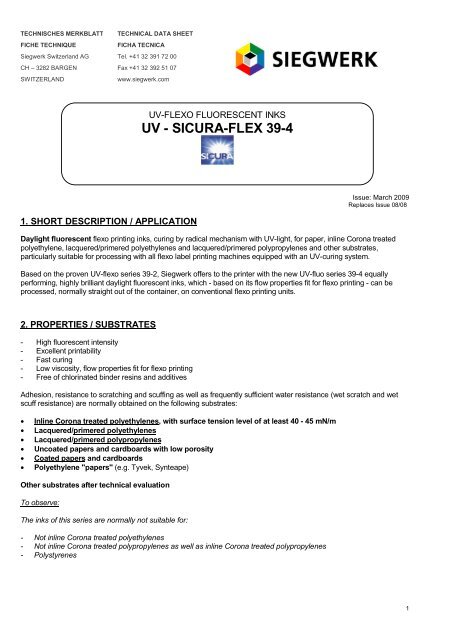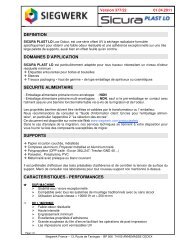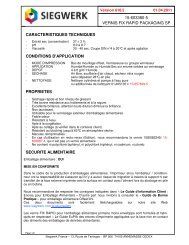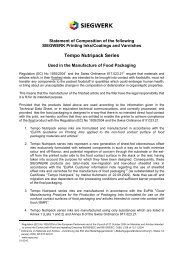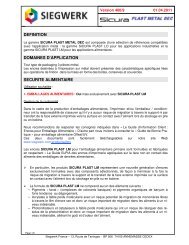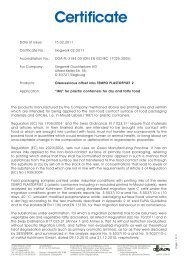UV - SICURA-FLEX 39-4
UV - SICURA-FLEX 39-4
UV - SICURA-FLEX 39-4
You also want an ePaper? Increase the reach of your titles
YUMPU automatically turns print PDFs into web optimized ePapers that Google loves.
TECHNISCHES MERKBLATT TECHNICAL DATA SHEET<br />
FICHE TECHNIQUE<br />
FICHA TECNICA<br />
Siegwerk Switzerland AG Tel. +41 32 <strong>39</strong>1 72 00<br />
CH – 3282 BARGEN Fax +41 32 <strong>39</strong>2 51 07<br />
SWITZERLAND<br />
www.siegwerk.com<br />
<strong>UV</strong>-<strong>FLEX</strong>O FLUORESCENT INKS<br />
<strong>UV</strong> - <strong>SICURA</strong>-<strong>FLEX</strong> <strong>39</strong>-4<br />
Issue: March 2009<br />
Replaces Issue 08/08<br />
1. SHORT DESCRIPTION / APPLICATION<br />
Daylight fluorescent flexo printing inks, curing by radical mechanism with <strong>UV</strong>-light, for paper, inline Corona treated<br />
polyethylene, lacquered/primered polyethylenes and lacquered/primered polypropylenes and other substrates,<br />
particularly suitable for processing with all flexo label printing machines equipped with an <strong>UV</strong>-curing system.<br />
Based on the proven <strong>UV</strong>-flexo series <strong>39</strong>-2, Siegwerk offers to the printer with the new <strong>UV</strong>-fluo series <strong>39</strong>-4 equally<br />
performing, highly brilliant daylight fluorescent inks, which - based on its flow properties fit for flexo printing - can be<br />
processed, normally straight out of the container, on conventional flexo printing units.<br />
2. PROPERTIES / SUBSTRATES<br />
- High fluorescent intensity<br />
- Excellent printability<br />
- Fast curing<br />
- Low viscosity, flow properties fit for flexo printing<br />
- Free of chlorinated binder resins and additives<br />
Adhesion, resistance to scratching and scuffing as well as frequently sufficient water resistance (wet scratch and wet<br />
scuff resistance) are normally obtained on the following substrates:<br />
• Inline Corona treated polyethylenes, with surface tension level of at least 40 - 45 mN/m<br />
• Lacquered/primered polyethylenes<br />
• Lacquered/primered polypropylenes<br />
• Uncoated papers and cardboards with low porosity<br />
• Coated papers and cardboards<br />
• Polyethylene "papers" (e.g. Tyvek, Synteape)<br />
Other substrates after technical evaluation<br />
To observe:<br />
The inks of this series are normally not suitable for:<br />
- Not inline Corona treated polyethylenes<br />
- Not inline Corona treated polypropylenes as well as inline Corona treated polypropylenes<br />
- Polystyrenes<br />
1
TECHNISCHES MERKBLATT<br />
FICHE TECHNIQUE<br />
TECHNICAL DATA SHEET<br />
FICHA TECNICA<br />
Special applications:<br />
• Thermal papers:<br />
- Except for special new paper qualities, inks of this series are not suitable for economic thermal papers due<br />
to the darkening of the thermo-sensitive layer.<br />
- Due to the poor heat-smear resistance, the prints with inks of this series are not imprintable by thermoprinting.<br />
They are therefore only suitable for top-coat thermal papers, if the fluorescent prints do not come<br />
into contact with the hot printing thermoelements.<br />
• Thermal transfer/Suitability for hot stamping: The imprintability of the inks of this series by thermal transfer<br />
resp. hot stamping is limited to good. The good acceptance of the print image depends largely on the surface<br />
smoothness of the substrate, the quality of the ribbon and the type of the printer. Contact our technical department<br />
for more information.<br />
Contact our technical department for more information<br />
To observe:<br />
- Before the print job is started, new materials, in particular special plastic substrates, must be checked for<br />
compatibility with the inks of this series or with the planned ink/overprinting varnish combination, even if their<br />
suitability on a comparable type of the same substrate group is proved.<br />
The test prints are to be examined, in case of self-adhesive labels after die-cutting (in particular at the edges),<br />
for adhesion, resistance to scratching and water (resistance to wet scratching and scuffing), resistance of the<br />
printed ink to the packaging contents and other application-specific requirements.<br />
- Before starting a new print job on a known material, but with new shades and/or new ink resp. ink/varnish<br />
combinations, please verify whether the resistances and, if applicable, other properties fulfill the applicationspecific<br />
requirements.<br />
- If you intend to produce for packagings which are subsequently to be filled with odor-sensitive contents, please<br />
make sure that the typical odor of the prints will not affect them.<br />
If you want to print on materials which will later be used as an immediate food wrapper or which will be placed<br />
close to food, please contact Siegwerk. Read our Technical Information "<strong>UV</strong>- and electron-beam curing printing<br />
inks and varnishes: Physiological harmlessness and suitability for food packagings" (available on request).<br />
- Unprimered polyethylene substrates sometimes contain lubricants, which migrate to the surface e.g. during<br />
storage. Such substances may be present even if the measured surface tension is higher than 42 mN/m; they<br />
can negatively influence the adhesion, the scratch and water resistance of the printed inks.<br />
In case of doubt, please contact in time our technical department.<br />
Fastnesses<br />
The particular fluorescent intensity of the products of this series is based on soluble fluorescent dyes, which perform<br />
considerably lower light and product fastnesses compared to the usual insoluble color pigments. Consequently, water<br />
resistance (wet scratch and wet scuff resistance) and resistances to the packaging contents (scratch and scuff<br />
resistance after contact with the product) are limited. The following restrictions of use have therefore to be respected.<br />
www.siegwerk.com 2
TECHNISCHES MERKBLATT<br />
FICHE TECHNIQUE<br />
TECHNICAL DATA SHEET<br />
FICHA TECNICA<br />
To observe:<br />
- The light fastness of usual prints, applied in one printing unit, is normally around WS 1. As a rule, these daylight<br />
fluorescent inks are – even if overprint varnished - therefore not suitable for use in direct sunlight. Nevertheless,<br />
practice shows that their fluorescent intensity is preserved up to 6 month in artificial light.<br />
Remark: if you print the same fluorescent ink – applying two layers - in two printing units, you may nearly double<br />
the light fastness up to WS 2.<br />
- Prints which are not overvarnished bleed-out and are poorly resistant to water, fat, foods, cosmetics, lotions,<br />
shampoos, alcohol, cleaning agents and solvents.<br />
Therefore, the inks are normally not suitable for direct printing on materials, which will later be used as an<br />
immediate food wrapper or which will be placed close to food.<br />
- Due to their poor resistance to sweat and saliva, the products of this series are not suitable for toys.<br />
3. INSTRUCTIONS FOR PRINTING AND PROCESSING<br />
Overprint varnishing<br />
If higher gloss, better mechanical resistance, improved fastness to packaging contents or moisture and/or other specific<br />
properties are required, overprint varnishing in a <strong>UV</strong>-flexo varnishing unit with one of the mentioned or another suitable<br />
<strong>UV</strong>-flexo varnish is necessary. Please consult the correspondent Technical information.<br />
BARGO<strong>FLEX</strong> <strong>UV</strong> varnish 85-601805-6.2360 (<strong>39</strong>-0-0189):<br />
Universal high performance varnish for plastic<br />
substrates, high gloss, very high resistances<br />
BARGO<strong>FLEX</strong> <strong>UV</strong> varnish 85-601583-9.1470 (<strong>39</strong>-0-0126-2): For plastic substrates, high gloss, high resistances<br />
BARGO<strong>FLEX</strong> <strong>UV</strong> varnish 85-601797-5.1490 (<strong>39</strong>-6-1004): Based on <strong>UV</strong> flexo series <strong>39</strong>-6 for plastic substrates,<br />
improves suitability for thermal transfer/hot<br />
stamping<strong>39</strong>-6 for plastic substrates, improves<br />
suitability for thermal transfer/hot stamping<br />
To observe:<br />
Each new substrate/ink/overprint varnish combination requires a test print and an evaluation, in case of label<br />
materials after die-cutting (in particular at the edges), for the required extent of mechanical resistances (e.g. scratch<br />
and rub resistance, adhesion), of resistances to the packaging contents and water (resistance to wet scratching and<br />
scuffing) and for other application-specific requirements.<br />
In case of doubt, please contact in time our technical department.<br />
Lamination<br />
To observe:<br />
Due to poor bond strength values, the fluorescent inks of this series are normally not suitable to be overlaminated.<br />
www.siegwerk.com 3
TECHNISCHES MERKBLATT<br />
FICHE TECHNIQUE<br />
TECHNICAL DATA SHEET<br />
FICHA TECNICA<br />
Curing<br />
Suitable for curing the inks of this series are medium pressure mercury vapor <strong>UV</strong> emitters with a power of at least 120-<br />
200 W/linear cm. Optimum results can be achieved using high performance quartz coated aluminum reflectors, which<br />
reflect almost the total <strong>UV</strong> radiation across the whole spectrum, but eliminating the infrared portion (e.g. by the aid of<br />
the "cold mirror" technology). Such reflectors yield maximum radiation density at minimum web heat load.<br />
To observe:<br />
Strong <strong>UV</strong> radiation destroys the daylight fluorescent dyes of these inks. Starting from a dose, which<br />
corresponds at medium printing speed (around 70 m/min) to two <strong>UV</strong> lamps of 100 W/linear cm each (equal to 200<br />
W/linear cm), weakening of the fluorescent intensity has to be expected. As a matter of fact, the tolerance between<br />
optimum curing and preserving the fluorescent intensity is relatively narrow.<br />
Therefore you must observe the following:<br />
- Limit the <strong>UV</strong> radiation dose, to which each fluorescent print is exposed on the printing machine in total, to the<br />
lowest possible value necessary for the required degree of curing.<br />
- Print these fluorescent inks always in the last possible printing unit.<br />
Printing<br />
Printing in two printing units:<br />
Normally you may improve the resulting fluorescent intensity overproportionally if you print the same fluorescent ink in<br />
two layers – under the condition that the image to be printed allows this. Compared to the single layer print, you will<br />
obtain nearly a three-fold intensity. Due to the double surface concentration of the fluorescent dyes, you will in parallel<br />
normally double the light fastness of the print.<br />
Anilox rollers:<br />
Depending on printing image, substrate and choice of single or double layer printing, e.g. laser-engraved ceramic anilox<br />
rollers (with doctor blade) with a 120 screen/cm and F. 14 (*) or higher can be used.<br />
(* F = theoretical ink transfer in g/m 2 )<br />
To observe:<br />
- If you intend to use anilox rollers with a diameter less than 60 mm, you should prefer a theoretical ink transfer<br />
about 25 % higher than the above values.<br />
- Due to the solids content of these inks being 100 % and their consequently higher viscosity compared to solvent<br />
or water based inks, printing without doctor blade is not possible.<br />
Printing plates:<br />
In principle, photopolymer plates are suitable. However, the resistance to the products of this series has to be tested<br />
individually.<br />
www.siegwerk.com 4
TECHNISCHES MERKBLATT<br />
FICHE TECHNIQUE<br />
TECHNICAL DATA SHEET<br />
FICHA TECNICA<br />
Ink preparation<br />
To observe:<br />
- Stir up well each ink before use. Before processing such products, please make sure that all components are<br />
well dispersed again.<br />
- In principle, the inks of this series are miscible with the inks of BARGO<strong>FLEX</strong> <strong>UV</strong>-Series <strong>39</strong>-2. However, even<br />
minimal admixtures of normal colored inks normally destroy the fluorescent power.<br />
Exception: by admixture of small amounts of Green (Pantone C) to Greenish Fluorescent Yellow you obtain<br />
Fluorescent Green shades.<br />
Cleaning<br />
The inks can be removed from rollers and tools by cleaner 10-650038-2 (V 316) or methoxypropanol.<br />
To observe:<br />
Reactive <strong>UV</strong> thinners are not suitable for cleaning.<br />
4. SHELF LIFE<br />
The inks of this series have under normal conditions a shelf life of at least 6 month. Within this period the products are<br />
usable in conformity with the indications of this data sheet.<br />
Normal conditions mean:<br />
- storage in firmly closed, not yet tapped containers;<br />
- temperatures not exceeding 20°C for weeks or 25°C for days.<br />
The shelf life can be extended by cool storage below 15°C.<br />
To observe:<br />
Do not expose open containers to direct sunlight or strong light sources.<br />
www.siegwerk.com 5
TECHNISCHES MERKBLATT TECHNICAL DATA SHEET<br />
FICHE TECHNIQUE<br />
FICHA TECNICA<br />
Siegwerk Switzerland AG Tel. +41 32 <strong>39</strong>1 72 00<br />
CH – 3282 BARGEN Fax +41 32 <strong>39</strong>2 51 07<br />
SWITZERLAND www.siegwerk.com<br />
5. BASIC SHADES / LIST OF PRODUCTS<br />
Product Name Pantone C Old Product Nr. New Product Nr.<br />
Light Resistance<br />
according to<br />
wool scale WS<br />
(ISO 2835)<br />
Alcali-/ Soap<br />
Resistance (ISO<br />
2838 / ISO<br />
28<strong>39</strong>)<br />
Alcohol- and<br />
Nitro-solvent<br />
Resistance (ISO<br />
2837)<br />
Resistance to<br />
saliva and sweat<br />
(DIN 53160)<br />
<strong>39</strong>-6 Fluorescent<br />
Yellow<br />
<strong>39</strong>-4-0330 81-321643-9.2730<br />
1 No No No<br />
<strong>39</strong>-6 Fluorescent<br />
Yellow PMS 803 C 803 C <strong>39</strong>-4-1230 81-321644-7.2730 1 No No No<br />
<strong>39</strong>-6 Fluorescent<br />
Orange 804 C <strong>39</strong>-4-1630 81-706072-6.2730 1 No No No<br />
<strong>39</strong>-6 Fluorescent Red 805 C <strong>39</strong>-4-3030 81-844123-0.2730 1 No No No<br />
Fluorescent Pink 806 C <strong>39</strong>-4-4530 81-844118-0.2730 1 No No No<br />
<strong>39</strong>-6 Fluorescent<br />
Violet 807 C <strong>39</strong>-4-5430 81-106626-5.2730 1 No No No<br />
<strong>39</strong>-6 Fluorescent<br />
Blue 801 C <strong>39</strong>-4-5630 81-113309-9.2730 1 No No No<br />
<strong>39</strong>-6 Fluorescent<br />
Green 802 C <strong>39</strong>-4-7930 81-514469-6.2730 1 No No No<br />
Packing code: It concerns a standard cask. If you wish another packing size, we will be pleased to send you the appropriate packing code.<br />
(*) Special basic shades for special ink shades<br />
WS = Wool scale acc. to ISO 2835/DIN 16525 (1 = poorest, 8 = highest light resistance)<br />
6
TECHNISCHES MERKBLATT TECHNICAL DATA SHEET<br />
FICHE TECHNIQUE<br />
FICHA TECNICA<br />
Siegwerk Switzerland AG Tel. +41 32 <strong>39</strong>1 72 00<br />
CH – 3282 BARGEN Fax +41 32 <strong>39</strong>2 51 07<br />
SWITZERLAND<br />
www.siegwerk.com<br />
6. SECURITY<br />
Classification:<br />
Switzerland: Toxicity class 4<br />
EU:<br />
To observe:<br />
Irritant (Xi). Irritating to eyes and skin (R36/38). May cause sensitization by skin contact (R43).<br />
Contains acrylates and hexanedioldiacrylate.<br />
Safety data/Information on composition<br />
Do not handle products without having consulted the corresponding safety data sheets. We<br />
supply them together with the first shipment to your safety manager.<br />
7. HSE<br />
Product Safety<br />
Intended Use<br />
Food Packaging:<br />
no<br />
Compliance Management<br />
Only intended for food packaging if the processing conditions rule out the possibility of set-off in the reel or stack and<br />
the design of the final printed article ensures reliable functional barrier properties to migration.<br />
The “Customer Guidance: Printing Inks for Food Packaging”, in Appendix 2 “the Selection of the Ink Product”<br />
http://www.siegwerk.com/en/customer-segments/sheetfed-uv/service.html has to be observed.<br />
Because of the differences in materials for printing, processing conditions and test criteria this Technical Data Sheet can only be of advisory<br />
character.<br />
Our data reflect the latest state of our knowledge and are based on the characteristics established in the laboratory and on practical experience.<br />
Your own tests with the original materials under the respective conditions are indispensable.<br />
We disclaim any liability for applications for which this ink series is not foreseen.<br />
<strong>39</strong>_4 FWo/AWe<br />
7


